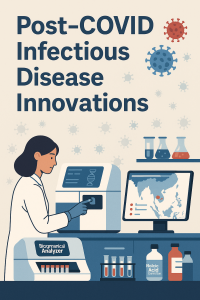Infectious Disease Preparedness in Southeast Asia: Post-COVID Innovations
Post-COVID Infectious Disease Innovation in Southeast Asia
Discover how Southeast Asia is strengthening infectious disease preparedness post-COVID using biochemical analyzers and nucleic acid extractors.
 Introduction
Introduction
Southeast Asia has long been a hotspot for emerging infectious diseases such as dengue fever, avian flu, and more recently, COVID-19. In the wake of the pandemic, governments and healthcare providers across the region are rethinking their preparedness strategies. Central to this transformation is the adoption of high-throughput diagnostic technologies, particularly fully automatic biochemical analyzers and nucleic acid extraction machines. These innovations are reshaping the region’s disease detection capabilities and creating new opportunities for medical device exporters.
1. Shifting from Emergency Response to Long-Term Preparedness
COVID-19 highlighted the weaknesses of over-reliance on centralized labs. Countries like Indonesia, Vietnam, and the Philippines are now investing in decentralized diagnostic networks. This shift increases demand for:
-
Portable or mid-sized biochemical analyzers
-
Standalone nucleic acid extraction systems for regional hospitals and labs
2. Fully Automatic Biochemical Analyzers: A Frontline Tool
These machines are essential in infectious disease control for:
-
Liver and kidney function monitoring (e.g., during dengue or hepatitis)
-
CRP and inflammatory markers tracking
-
Evaluating organ damage post-infection
High-speed, automated analyzers reduce technician workload and enhance lab throughput—an urgent requirement in outbreak situations.
3. Nucleic Acid Extraction Systems: Core to Molecular Diagnostics
Molecular testing has become the gold standard for early disease detection. Nucleic acid extractors are widely used to identify:
-
SARS-CoV-2 (COVID-19)
-
Dengue and Zika viruses
-
Influenza A/B, H5N1, and other respiratory pathogens
Automated extraction reduces human error and improves test consistency—vital for both government labs and private hospitals.
4. National Investment in Diagnostic Infrastructure
Governments in Southeast Asia are prioritizing public health resilience. Examples include:
-
Vietnam: Expansion of district-level labs with biochemical and molecular testing capabilities
-
Malaysia: Public-private partnerships to deploy mobile diagnostic units
-
Thailand: National lab strategy for early outbreak detection and AI integration
5. Opportunities for Medical Device Exporters
The demand for mid- to high-end diagnostic equipment is growing, especially in:
-
Regional hospitals upgrading infection control labs
-
Private chains expanding preventive health services
-
Government tenders for pandemic preparedness stockpiles
Manufacturers offering CE/ISO-certified biochemical and nucleic acid testing devices are particularly well-positioned.
6. Integration with AI and Digital Health Platforms
Modern diagnostic machines are increasingly integrated with:
-
AI platforms for real-time outbreak tracking
-
Cloud-based lab data systems for faster epidemiological reporting
-
Mobile apps used by public health teams in the field
These integrations improve speed, traceability, and policy response.
Conclusion
Southeast Asia’s infectious disease strategy is shifting from reactive to proactive, powered by technology. Fully automatic biochemical analyzers and nucleic acid extractors are not only improving diagnostic speed and accuracy but also opening doors for global manufacturers to serve this expanding market. For medical device exporters, the message is clear: the future of disease preparedness in Southeast Asia is smart, distributed, and diagnostics-driven.
👉 Learn more about reliable diagnostic solutions at www.xinrea.com
